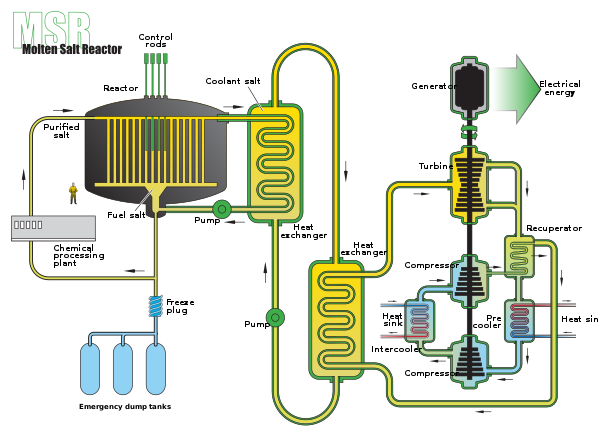 In rocket engines, the reaction also releases heat which will warm up the product. Since when you heat a substance it expands (try this with a crayon and a magnifying glass), the heat produced by the chemical reaction heats up the product, making it expand. As it expands, it gets too big for the reaction chamber and pushes out the back of the rocket. This provides thrust for the rocket.
In rocket engines, the reaction also releases heat which will warm up the product. Since when you heat a substance it expands (try this with a crayon and a magnifying glass), the heat produced by the chemical reaction heats up the product, making it expand. As it expands, it gets too big for the reaction chamber and pushes out the back of the rocket. This provides thrust for the rocket.
Current space-flight depends on a rocket that burns fuel and oxidizer, which turns out to be both expensive and deficient as a means of propulsion for long-distance space travel, explains Lozano. Chemical-based rockets get terrible fuel efficiency, achieving very little thrust per kilogram of propellant used, and their exhaust velocity can’t exceed 5,000 meters per second. Using these tools, Lozano adds, it would take at least nine months to get to Mars (if your timing and the planets’ alignment are just right), and “the rockets would be huge compared to the payload.”
Electromagnetic propulsion (EMP), is the principle of accelerating an object by the utilization of a flowing electrical current and magnetic fields. The electrical current is used to either create an opposing magnetic field, or to charge a fluid, which can then be repelled. It is well known that when a current flows through a conductor in a magnetic field, an electromagnetic force known as a Lorentz force, pushes the conductor in a direction perpendicular to the conductor and the magnetic field. This repulsing force is what causes propulsion in a system designed to take advantage of the phenomenon. The term electromagnetic propulsion (EMP) can be described by its individual components: electromagnetic- using electricity to create a magnetic field (electromagnetism), and propulsion- the process of propelling something. One key difference between EMP and propulsion achieved by electric motors is that the electrical energy used for EMP is not used to produce rotational energy for motion; though both use magnetic fields and a flowing electrical current.
plasma-based propulsion system. An electric power source is used to ionize fuel into plasma. Electric fields heat and accelerate the plasma while the magnetic fields direct the plasma in the proper direction as it is ejected from the engine, creating thrust for the spacecraft. The engine can even vary the amount of thrust generated, allowing it to increase or decrease its acceleration. It even features an "afterburner" mode that sacrifices fuel efficiency for additional speed. Possible fuels for the VASIMR engine could include hydrogen, helium, and deuterium.
The use of hydrogen as the fuel for the VASIMR project has many side benefits, according to researcher Franklin Chang-Diaz. In addition to being the director of the Advanced Space Propulsion Laboratory, Chang-Diaz is an astronaut who has flown into space on seven missions, more than any other NASA astronaut. "We're likely to find hydrogen pretty much anywhere we go in the solar system," he said. What this means is that a VASIMR-powered spacecraft could be launched with only enough fuel to get to its destination, such as Mars, and then pick up more hydrogen upon arrival to serve as fuel for the return trip home. Another benefit of hydrogen fuel is that hydrogen is the best known radiation shield, so the fuel for the VASIMR engine could also be used to protect the crew from harmful effects of radiation exposure during the flight.
The future of space propulsion maybe in the use of plasma pushed by the repelling force of magnetism.
But o achieve his much-repeated claim that VASIMR could enable a 39-day one-way transit to Mars, Chang Diaz posits a nuclear reactor system with a power of 200,000 kilowatts and a power-to-mass ratio of 1,000 watts per kilogram. In fact, the largest space nuclear reactor ever built, the Soviet Topaz, had a power of 10 kilowatts and a power-to-mass ratio of 10 watts per kilogram. There is thus no basis whatsoever for believing in the feasibility of Chang Diaz’s fantasy power system.
Chang Diaz’s hypothetical 200,000-kilowatt nuclear electric spaceship would have a launch mass of 7,700 metric tons, including 4,000 tons of very expensive and very radioactive high-technology reactor system hardware requiring maintenance support from a virtual parallel universe of futuristic orbital infrastructure. Yet it would still get to Mars no quicker than the 6-month transit executed by the Mars Odyssey spacecraft using chemical propulsion in 2001, and which could be readily accomplished by a human crew launched directly to Mars by a heavy-lift booster no more advanced than the (140-ton-to-orbit) Saturn 5 employed to send astronauts to the Moon in the 1960s.
It would suggest that nuclear power is needed to make the electrical energy to power such a propulsion engine like Vasimir. The current nuclear reactor technology is both lethal and complex to run, though one such technology like the thorium reactor could might work. The forgotten research to put a working reactor in a aircraft in the 1950's could supply the electrical energy needed in such a engine. There are no such plans in the pipeline to put reactor technology in space for propulsion test. But I an ever hopeful that someone would make the connection and propose plans even for a propulsion test.





No comments:
Post a Comment